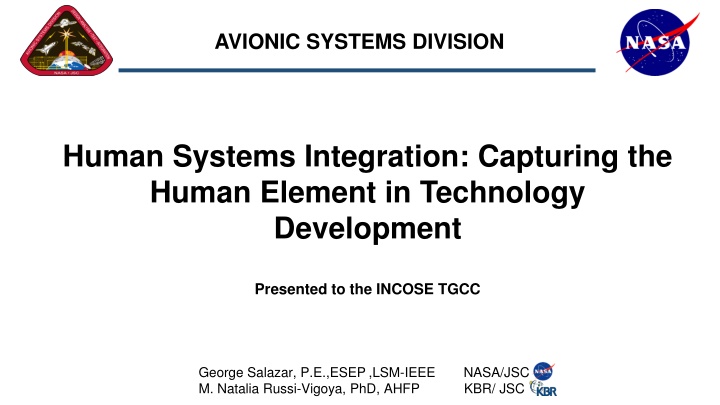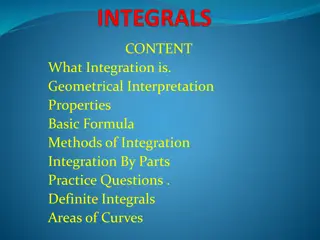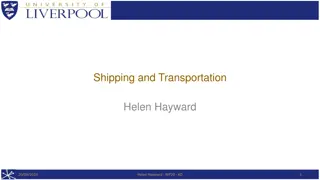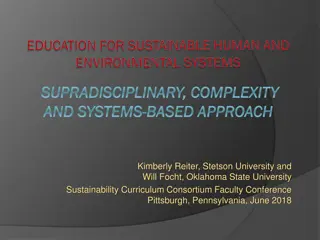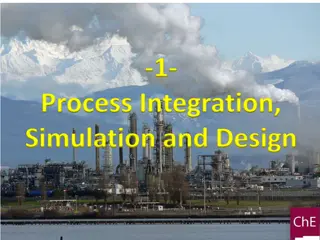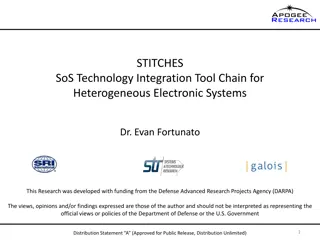Human Systems Integration in Technology Development
Human Systems Integration (HSI) is a crucial interdisciplinary process in systems engineering that integrates human factors to enhance system design, reduce costs, and optimize performance. This presentation by NASA experts delves into the benefits of HSI, the human readiness level metrics, and its role in technology development. Through HSI, technology can be tailored to human capabilities and limitations, leading to improved system performance and efficiency.
Download Presentation

Please find below an Image/Link to download the presentation.
The content on the website is provided AS IS for your information and personal use only. It may not be sold, licensed, or shared on other websites without obtaining consent from the author.If you encounter any issues during the download, it is possible that the publisher has removed the file from their server.
You are allowed to download the files provided on this website for personal or commercial use, subject to the condition that they are used lawfully. All files are the property of their respective owners.
The content on the website is provided AS IS for your information and personal use only. It may not be sold, licensed, or shared on other websites without obtaining consent from the author.
E N D
Presentation Transcript
AVIONIC SYSTEMS DIVISION Human Systems Integration: Capturing the Human Element in Technology Development Presented to the INCOSE TGCC George Salazar, P.E.,ESEP ,LSM-IEEE M. Natalia Russi-Vigoya, PhD, AHFP NASA/JSC KBR/ JSC
Overview Purpose: Provide a high-level awareness of the Human Systems Integration(HSI) process and the human readiness complement of technology readiness level(TRL) to manage and maximizing system performance. Topics: What is Human Systems Integration (HSI)? Expected benefits of HSI HSI in the development process Human Readiness Level (HRL) Metrics Closing Remarks Gateway Pre-Decisional NASA and ISS International Partner Internal Use Only Do Not Distribute This document may only be released according to the Destination Control Statement on the front cover. 2
Overview Topics: What is Human Systems Integration (HSI)? Expected Benefits of HSI Human Systems Integration (HSI) In the Development Process Human Readiness Level Metrics Closing Remarks Gateway Pre-Decisional NASA and ISS International Partner Internal Use Only Do Not Distribute This document may only be released according to the Destination Control Statement on the front cover. 3
What is Human Systems Integration (HSI)? HSI is defined as the interdisciplinary technical and management processes as part of the systems engineering process for integrating human considerations within and across all system elements to enhance human system design, reduce life-cycle ownership cost, and optimize total system performance - Human treated equally with H/W and S/W - Designing systems with human capabilities and limitations in mind Gateway Pre-Decisional NASA and ISS International Partner Internal Use Only Do Not Distribute This document may only be released according to the Destination Control Statement on the front cover. 4
NASA Human Systems Integration (HSI) Domains Domains Interactions (Notional) NASA Domains 5 Gateway Pre-Decisional NASA and ISS International Partner Internal Use Only Do Not Distribute This document may only be released according to the Destination Control Statement on the front cover. 5
Next Topics: What is Human Systems Integration (HSI)? Expected Benefits of HSI Human Systems Integration (HSI) In the Development Process Human Readiness Level Metrics Closing Remarks Gateway Pre-Decisional NASA and ISS International Partner Internal Use Only Do Not Distribute This document may only be released according to the Destination Control Statement on the front cover. 6
Cost Reduction and System Performance Minimize cost escalation in complex system development Hardware and software has enormous capabilities with more internal and external interactions Artificial Intelligence in system decision making adds further complexity Committed Life Cycle Cost against Time (Credit: INCOSE SE HdBk V.3.1) Reduce risks such as late rework and increased operating costs Maximize total system performance, safety, and operations by considering the human throughout the system development life-cycle Gateway Pre-Decisional NASA and ISS International Partner Internal Use Only Do Not Distribute This document may only be released according to the Destination Control Statement on the front cover. 7
Human Error and Hazard Mitigation Requirements Design Safety Training Maintenance Crew (Adapted from Reason, 1990) (Karmaker, and Chowdhury, 1991) Gateway Pre-Decisional NASA and ISS International Partner Internal Use Only Do Not Distribute This document may only be released according to the Destination Control Statement on the front cover. 8
Myth --HFE and HSI Are the Same? Human Factoring Engineering Human Systems Integration Safety Machine Design Match Machine To task Task Design Maintenance & Sustainment Operations HSI HFE Match machine To Human Match Task To Human HFE Habitability Human Training Main Goal: Ensure the human elements of the total system are effectively integrated with hardware Main Goal: Improve performance, enhance safety, and increase user satisfaction Gateway Pre-Decisional NASA and ISS International Partner Internal Use Only Do Not Distribute This document may only be released according to the Destination Control Statement on the front cover. and software elements 9
Observations In Applying HSI Few project managers understand the importance of HSI Most systems engineers understand integrating all systems to ensure system success Not fully appreciate is the human + system engineer for optimal performance Most designers understand H/W and S/W - not humans! Think about your engineering studies HSI practitioners must be engaged early in development as the practitioner does not have the option to redesign the human to fit the system Challenge in coordinating across HSI domains with SE to understand each other s languages, metrics, and concerns-important for communications and compromise Gateway Pre-Decisional NASA and ISS International Partner Internal Use Only Do Not Distribute This document may only be released according to the Destination Control Statement on the front cover. 10
Next Topics: What is Human Systems Integration (HSI)? Expected Benefits of HSI Human Systems Integration (HSI) In the Development Process Human Readiness Level Metrics Closing Remarks Gateway Pre-Decisional NASA and ISS International Partner Internal Use Only Do Not Distribute This document may only be released according to the Destination Control Statement on the front cover. 11
Systems Engineering/HSI Activity Interaction Total system (human, hardware, software, and environment) optimization happens in an integrated fashion and not components that have been independently optimized 12 Gateway Pre-Decisional NASA and ISS International Partner Internal Use Only Do Not Distribute This document may only be released according to the Destination Control Statement on the front cover. 12
What is it that we are trying to Achieve with Systems Engineering and HSI? Skills Abilities Experience As part of this group Can this astronaut With this training With no errors Perform these tasks Under these conditions The aim is not to train the astronaut to work a machine that is designed to achieve a goal: Rather, the aim is to design the machine to support the astronaut who is responsible to achieve the goal. Gateway Pre-Decisional NASA and ISS International Partner Internal Use Only Do Not Distribute This document may only be released according to the Destination Control Statement on the front cover. 13 Adapted from:Dr. Holly A.H. Handley:Human System Engineering Community Initiatives: From Human View to Human Readiness Level,3-2020
Next Topics: What is Human Systems Integration (HSI)? Expected Benefits of HSI Human Systems Integration (HSI) In the Development Process Human Readiness Level Metrics Closing Remarks Gateway Pre-Decisional NASA and ISS International Partner Internal Use Only Do Not Distribute This document may only be released according to the Destination Control Statement on the front cover. 14
Performance Metrics in System Development Traditional performance metrics in system development catered to the hardware/software Technical performance measures tools that show how well a system is satisfying its requirements or meeting its goals- providing insight into program risk Weight Power Memory Throughput For new technology Technology Readiness Level What about the human? User research will have different goals at the different stages of design (e.g., exploratory research will seek to identify mental models and natural interactions, higher fidelity prototypes may need to identify performance metrics (e.g., accuracy, time on task, task completion, ease of use, satisfaction, situation awareness, etc.) System/product/services human readiness needs to be done from the early stages of design to ensure that the technology level is meeting the user expectations requirements What is needed is a metrics to measure human system readiness for use of the technology being developed Human Readiness Level (HRL) as an ANSI standard It complements the Technology Readiness Level (TRL) Provides a simple way of determining the readiness of the technology for the human Gateway Pre-Decisional NASA and ISS International Partner Internal Use Only Do Not Distribute This document may only be released according to the Destination Control Statement on the front cover. 15
Quick Overview of Technology Readiness Level Formal metrics that support assessments of a particular technology towards maturity Advantages Facilitates the communication and shared understanding of technology status within and among diverse organizations Definitions embedded in the TRL scale actively promote testing and verification to assess maturity Gauge progress throughout development and plan anticipated levels of effort remaining to achieve a desired level of maturity Manage program schedule and cost risks with a strategy designed to prevent integrating technologies into the system before they are technically mature Disadvantages Does not address interaction/integration readiness of different technologies with various TRLs No direct measure of risk, cost, or the feasibility of deployment TRL only for the environment intended Inability to capture the human-related aspects of technology development and its critical role in the readiness of a technology for operational use Credit:NASA Gateway Pre-Decisional NASA and ISS International Partner Internal Use Only Do Not Distribute This document may only be released according to the Destination Control Statement on the front cover. 16
Proposed HRL Scale Level Technology Readiness Level Human Readiness Level System successfully used in operations across the operational envelope with systematic monitoring of human-system performance Production / Deployment 9 Operational use of deliverable (Flight proven) Complement and supplement TRL scale Total human-system performance fully tested, validated, and approved in mission operations, using completed system hardware and software and representative users Actual deliverable qualified through test and demonstration 8 Support decisions regarding time and resource investments Increasing Maturity Final development version of the deliverable demonstrated in operational environment Human systems design fully tested and verified in operational environment with system hardware and software and representative users 7 Human systems design fully matured as influenced by human performance analyses, metrics, prototyping, and high-fidelity simulations Identify human issues early in lifecycle to keep design change and cost down Representative of the deliverable demonstrated in relevant environments (PDR requirement) 6 Demonstration Technology Key elements demonstrated in relevant environments User evaluation of prototypes in mission- relevant simulations completed to inform design 5 Key elements demonstrated in laboratory environment Modeling, part-task testing, and trade studies of human systems design concepts completed 4 Provide leading indicators with evidence-based measures of human readiness & human error reduction Concepts demonstrated analytically or experimentally Requirements for supporting human performance established 3 Research & Development Human-focused concept of operations defined and human performance design principles established 2 Concept and application formulated Relevant human capabilities, limitations, and basic human performance issues and risks identified Basic principles observed and reported 1 Provide a single number to communicate readiness of a technology for human Gateway Pre-Decisional NASA and ISS International Partner Internal Use Only Do Not Distribute This document may only be released according to the Destination Control Statement on the front cover. use for high-level decision makers 17
Human Readiness Level (HRL) In the NASA Lifecycle HRL metrics provides an organization and program management with a simple number indicating the state of integration within the system with respect to humans and technology Risks when HRL lags TRL Like TRL, HRL provides a common understanding of human readiness to support management decisions about development, funding, risks, and life- cycle phases transition HRL scale looks at leading indicators(evidence-based measures of usability readiness) rather than lagging indicators of human readiness (human error in fielded systems) TRL 4/5 TRL 8 TRL 1-3 TRL 6 TRL 7 TRL 9 HRL 4/5 HRL 1-3 HRL 8 HRL 6 HRL 7 HRL 9 Notional Mapping of HRL/TRL to NASA Human Spaceflight Lifecycle Gateway Pre-Decisional NASA and ISS International Partner Internal Use Only Do Not Distribute This document may only be released according to the Destination Control Statement on the front cover. HRL soon to become an ANSI standard-ANSI/HFES 400-2021 in the fall of 2021 18
Overview Topics: What is Human Systems Integration (HSI)? Expected Benefits of HSI Human Systems Integration (HSI) In the Development Process Human Readiness Level Metrics Closing Remarks Gateway Pre-Decisional NASA and ISS International Partner Internal Use Only Do Not Distribute This document may only be released according to the Destination Control Statement on the front cover. 19
Closing Remarks Maximizes total system performance, safety, and operations by considering the human in the system s design, engineering, and operational environments. Reduce total ownership cost though the use of HSI. HRL provides a high-level status of technology ready for the human. HRLs assesses the degree that HSI requirements have been addressed. Gateway Pre-Decisional NASA and ISS International Partner Internal Use Only Do Not Distribute This document may only be released according to the Destination Control Statement on the front cover. 20
Gateway Pre-Decisional NASA and ISS International Partner Internal Use Only Do Not Distribute This document may only be released according to the Destination Control Statement on the front cover. 21
Backup Gateway Pre-Decisional NASA and ISS International Partner Internal Use Only Do Not Distribute This document may only be released according to the Destination Control Statement on the front cover. 22
Brief History of Human Engineering Processes at NASA 1965- MSFC STD 391, Human Factors Engineering Program establish minimum human factors requirements to promote the maximum effectiveness and reliability of humans as a system component. 1966-MSFC STD 267A, Human Engineering Design Criteria contained human engineering design principles and practices to be used by engineers in designing equipment for the satisfactory performance of operator, maintenance, and control personnel. 2008- NPR 8705.2B, Human Rating Requirements for Space Systems emphasis on the process of achieving human rating of space systems 2010-Human Integration Design Handbook for Human Space Flight, further enhancing NASA s focus on human centered design (HCD) 2013-NPR 7123.1B, NASA Systems Engineering Processes and Requirements, included the first formal definition of HSI in NASA documentation. 2014- NASA/TP 2014 218556, Human Integration Design Processes (HIDP) captured NASA human engineering and HSI lessons learned to supplement standards and requirements 2015-NASA STD 3001, NASA Space Flight Human System Standard, Volume 2: Human Factors, Habitability, and Environmental Health added requirement for HCD-significant step forward in capturing and documenting NASA s approach to HSI. 2015-NASA HSI Practitioner s Guide (HSIPG) was initial HSI guide provided much needed guidance on HSI team responsibilities, activities, and products, along with guidance on writing an HSI Plan (HSIP). Gateway Pre-Decisional NASA and ISS International Partner Internal Use Only Do Not Distribute This document may only be released according to the Destination Control Statement on the front cover. 23
